NCERT Solutions for Chapter 3 Pair of Linear Equations in Two Variables Class 10 Maths
Book Solutions1
Answer
Let present age of Aftab be x
And, present age of daughter is represented by y
Then Seven years ago,
Age of Aftab = x -7
Age of daughter = y-7
According to the question,
(x - 7) = 7 (y – 7 )
x – 7 = 7 y – 49
x- 7y = - 49 + 7
x – 7y = - 42 …(i)
x = 7y – 42
Putting y = 5, 6 and 7, we get
x = 7 × 5 - 42 = 35 - 42 = - 7
x = 7 × 6 - 42 = 42 – 42 = 0
x = 7 × 7 – 42 = 49 – 42 = 7
|
x |
-7 |
0 |
7 |
|
y |
5 |
6 |
7 |
Three years from now ,
Age of Aftab = x +3
Age of daughter = y +3
According to the question,
(x + 3) = 3 (y + 3)
x + 3 = 3y + 9
x -3y = 9-3
x -3y = 6 …(ii)
x = 3y + 6
Putting, y = -2, -1 and 0, we get
x = 3 ×(-2) + 6 = -6 + 6 =0
x = 3 ×(-1) + 6 = -3 + 6 = 3
x = 3 × 0 + 6 = 0 + 6 = 6
|
x |
0 |
3 |
6 |
|
y |
-2 |
-1 |
0 |
Algebraic representation
From equation (i) and (ii)
x – 7y = – 42
x - 3y = 6
Graphical representation
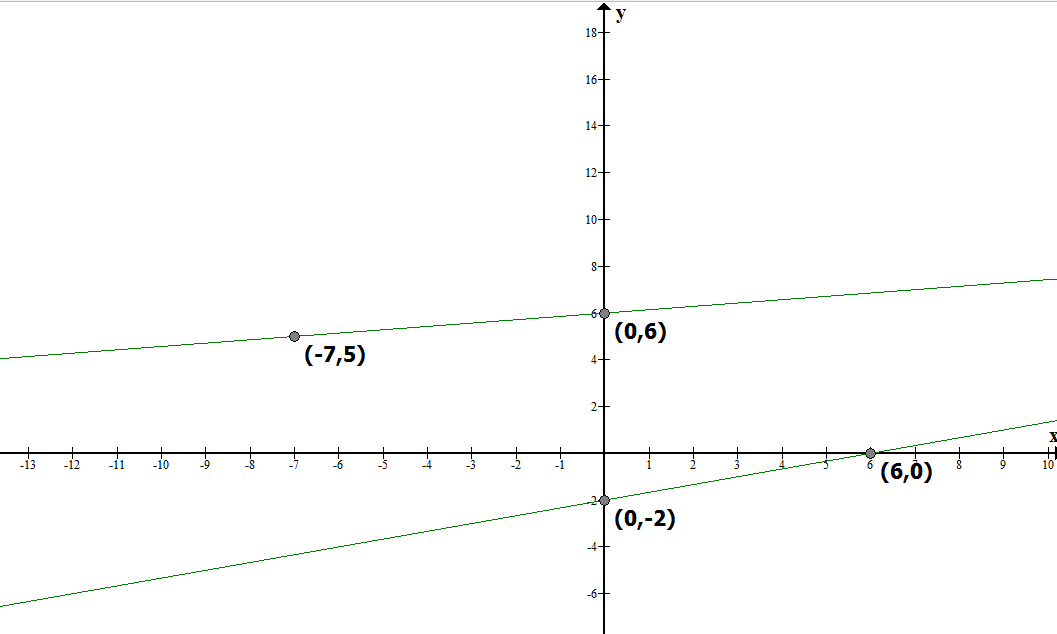
2
Answer
Let cost of one bat = Rs x
Cost of one ball = Rs y
3 bats and 6 balls for Rs 3900 So that
3x + 6y = 3900 … (i)
Dividing equation by 3, we get
x + 2y = 1300
Subtracting 2y both side we get
x = 1300 – 2y
Putting y = -1300, 0 and 1300 we get
x = 1300 – 2 (-1300) = 1300 + 2600 = 3900
x = 1300 -2(0) = 1300 - 0 = 1300
x = 1300 – 2(1300) = 1300 – 2600 = - 1300
|
x |
3900 |
1300 |
-1300 |
|
y |
-1300 |
0 |
1300 |
Given that she buys another bat and 2 more balls of the same kind for Rs 1300
So, we get
x + 2y = 1300 … (ii)
Subtracting 2y both side we get
x = 1300 – 2y
Putting y = - 1300, 0 and 1300 we get
x = 1300 – 2 (-1300) = 1300 + 2600 = 3900
x = 1300 – 2 (0) = 1300 - 0 = 1300
x = 1300 – 2(1300) = 1300 – 2600 = -1300
|
x |
3900 |
1300 |
-1300 |
|
y |
-1300 |
0 |
1300 |
Algebraic representation
3x + 6y = 3900
x + 2y = 1300
Graphical representation,
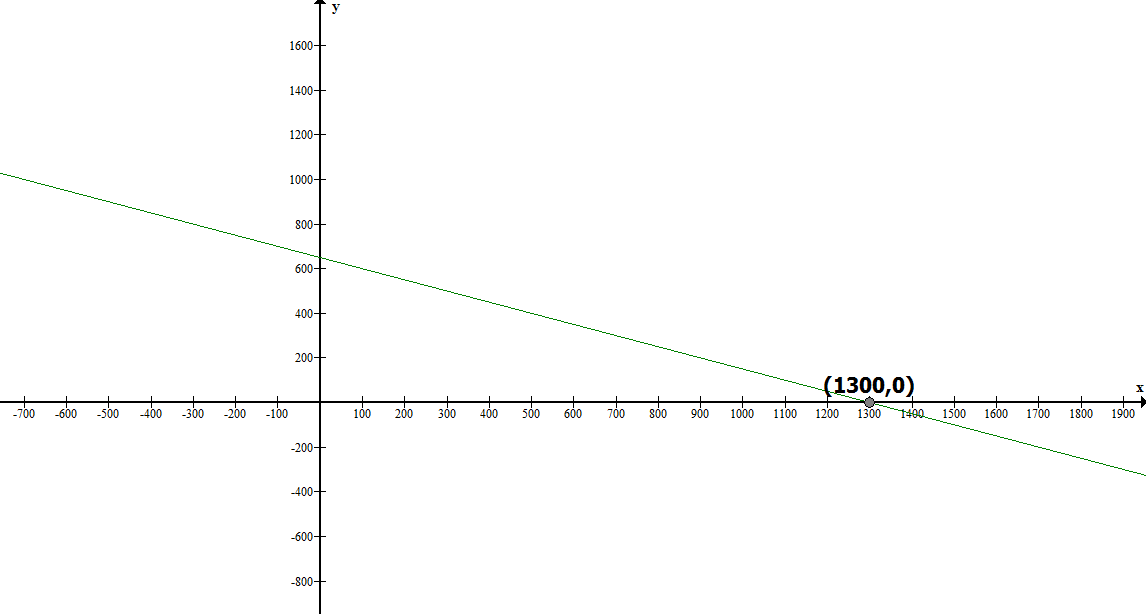
3
Answer
Let cost each kg of apples = Rs x
Cost of each kg of grapes = Rs y
Given that the cost of 2 kg of apples and 1kg of grapes on a day was found to be Rs 160
So that
2 x + y = 160 … (i)
2x = 160 - y
x = (160 – y)/2
Let y = 0 , 80 and 160, we get
x = (160 – ( 0 )/2 = 80
x = (160- 80 )/2 = 40
x = (160 – 2 × 80)/2 = 0
|
x |
80 |
40 |
0 |
|
y |
0 |
80 |
160 |
Given that the cost of 4 kg of apples and 2 kg of grapes is Rs 300
So we get
4x + 2y = 300 … (ii)
Dividing by 2 we get
2x + y = 150
Subtracting 2x both side, we get
y = 150 – 2x
Putting x = 0 , 50 , 100 we get
y = 150 – 2 × 0 = 150
y = 150 – 2 × 50 = 50
y = 150 – 2 × (100) = -50
|
x |
0 |
50 |
100 |
|
y |
150 |
50 |
-50 |
Algebraic representation,
2x + y = 160
4x + 2y = 300
Graphical representation,

1
Form the pair of linear equations in the following problems, and find their solutions graphically.
(i) 10 students of Class X took part in a Mathematics quiz. If the number of girls is 4 more than the number of boys, find the number of boys and girls who took part in the quiz.
(ii) 5 pencils and 7 pens together cost Rs 50, whereas 7 pencils and 5 pens together cost Rs 46. Find the cost of one pencil and that of one pen.
Answer
(i) Let number of boys = xNumber of girls = y
Given that total number of student is 10 so that
x + y = 10
Subtract y both side we get
x = 10 – y
Putting y = 0 , 5, 10 we get
x = 10 – 0 = 10
x = 10 – 5 = 5
x = 10 – 10 = 0
|
x |
10 |
5 |
|
y |
0 |
5 |
Given that If the number of girls is 4 more than the number of boys
So that,
y = x + 4
Putting x = -4, 0, 4, and we get
y = - 4 + 4 = 0
y = 0 + 4 = 4
y = 4 + 4 = 8
|
x |
-4 |
0 |
4 |
|
y |
0 |
4 |
8 |
Graphical representation
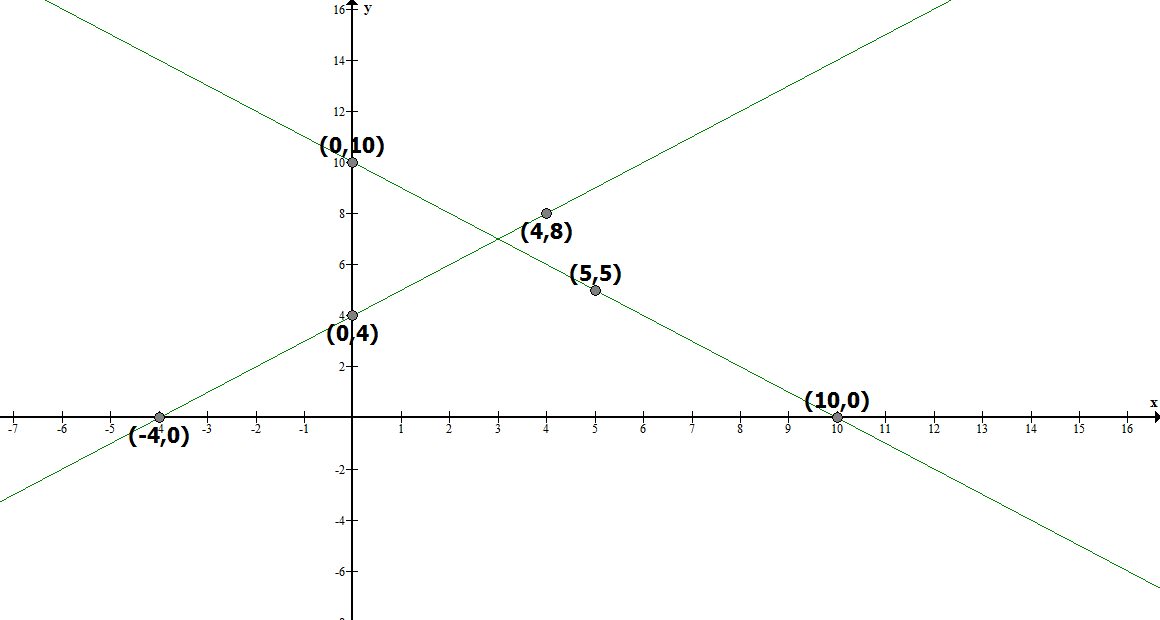
Therefore, number of boys = 3 and number of girls = 7
(ii) Let cost of pencil = Rs x
Cost of pens = Rs y
5 pencils and 7 pens together cost Rs 50,
So we get
5x + 7y = 50
Subtracting 7y both sides we get
5x = 50 – 7y
Dividing by 5 we get
x = 10 - 7 y /5
Putting value of y = 5 , 10 and 15 we get
x = 10 – 7 × 5/5 = 10 – 7 = 3
x = 10 – 7 × 10/5 = 10 – 14 = - 4
x = 10 – 7 × 15/5 = 10 – 21 = - 11
| x | 3 | -4 | -11 |
| y | 5 | 10 | 15 |
Given that 7 pencils and 5 pens together cost Rs 46
7x + 5y = 46
Subtracting 7x both side we get
5y = 46 – 7x
Dividing by 5 we get
y = 46/5 - 7x/5
y = 9.2 – 1.4x
Putting x = 0 , 2 and 4 we get
y = 9.2 – 1.4 × 0 = 9.2 – 0 = 9.2
y = 9.2 – 1.4 (2) = 9.2 – 2.8 = 6.4
y = 9.2 – 1.4 (4) = 9.2 – 5.6 = 3.6
| x | 0 | 2 | 4 |
| y | 9.2 | 6.4 | 3.6 |
Graphical representation

Therefore, cost of one pencil = Rs 3 and cost of one pen = Rs 5.
2
7x + 6y – 9 = 0
Answer
(i) 5x – 4y + 8 = 07x + 6y – 9 = 0
Comparing these equation with
a1x + b1y + c1 = 0
a2x + b2y + c2= 0
We get,
a1 = 5, b1 = -4, and c1 = 8
a2 =7, b2 = 6 and c2 = -9
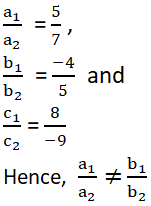
18x + 6y + 24 = 0
Comparing these equations with
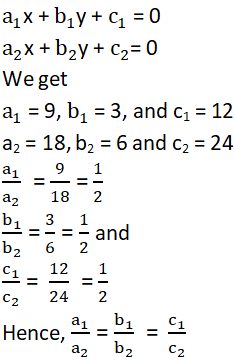
Comparing these equations with
a1x + b1y + c1 = 0
a2x + b2y + c2= 0
We get
a1 = 6, b1 = -3, and c1 = 10
a2 = 2, b2 = -1 and c2 = 9
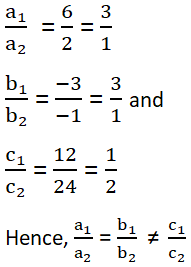
3
(i) 3x + 2y = 5 ; 2x – 3y = 7
(ii) 2x – 3y = 8 ; 4x – 6y = 9
(iii) 3/2x + 5/3y = 7 ; 9x – 10y = 14
(iv) 5x – 3y = 11 ; – 10x + 6y = –22
(v) 4/3x + 2y =8 ; 2x + 3y = 12
Answer
(i) 3x + 2y = 5 ; 2x – 3y = 7
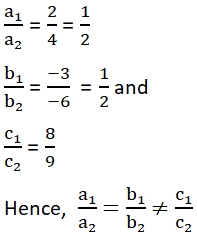
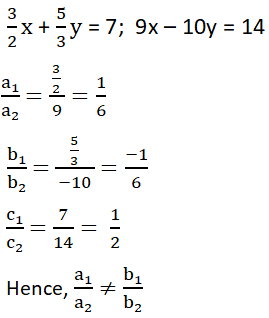
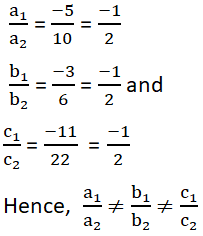
4
Which of the following pairs of linear equations are consistent/inconsistent? If consistent, obtain the solution graphically:
(i) x + y = 5, 2x + 2y = 10
(ii) x – y = 8, 3x – 3y = 16
(iii) 2x + y – 6 = 0, 4x – 2y – 4 = 0
(iv) 2x – 2y – 2 = 0, 4x – 4y – 5 = 0
Answer
(i) x + y = 5; 2x + 2y = 10
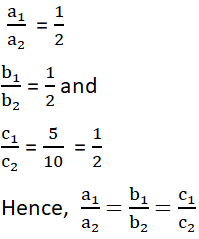
Therefore, these linear equations are coincident pair of lines and thus have infinite number of possible solutions. Hence, the pair of linear equations is consistent.
x + y = 5
x = 5 - y
|
x |
4 |
3 |
2 |
|
y |
1 |
2 |
3 |
And, 2x + 2y = 10
x = 10− ![]()
|
x |
4 |
3 |
2 |
|
y |
1 |
2 |
3 |
Graphical representation
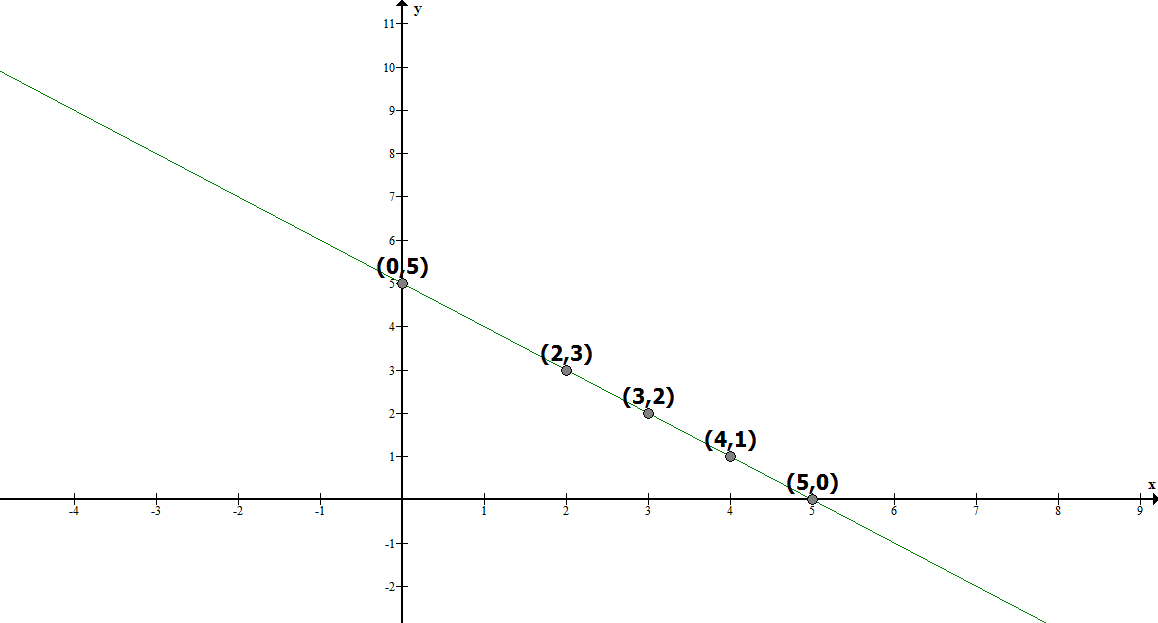
From the figure, it can be observed that these lines are overlapping each other. Therefore, infinite solutions are possible for the given pair of equations.
(ii) x – y = 8, 3x – 3y = 16

Therefore, these linear equations are parallel to each other and thus have no possible solution. Hence, the pair of linear equations is inconsistent.
(iii) 2x + y – 6 = 0, 4x – 2y – 4 = 0
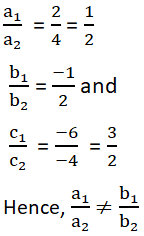
Therefore, these linear equations are intersecting each other at one point and thus have only one possible solution. Hence, the pair of linear equations is consistent.
2x + y - 6 = 0
y = 6 - 2x
|
x |
0 |
1 |
2 |
|
y |
6 |
4 |
2 |
And, 4x - 2y -4 = 0
y = 4x ![]()
|
x |
1 |
2 |
3 |
|
y |
0 |
2 |
4 |
Graphical representation
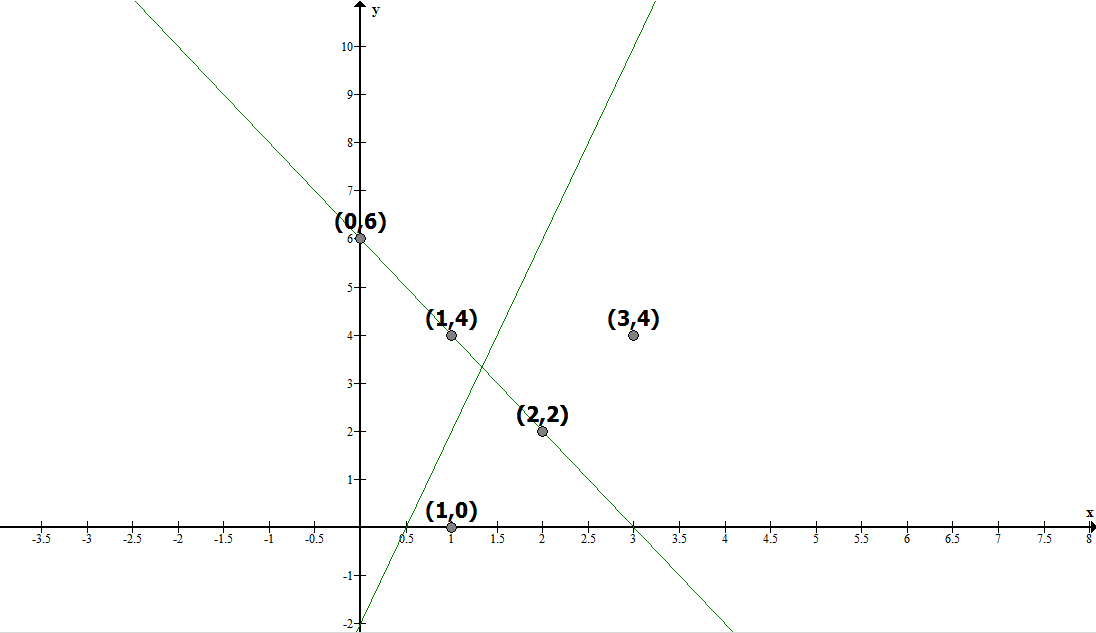
From the figure, it can be observed that these lines are intersecting each other at the only one point i.e., (2,2) which is the solution for the given pair of equations.
(iv) 2x – 2y – 2 = 0, 4x – 4y – 5 = 0
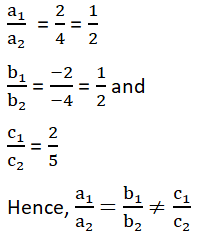
Therefore, these linear equations are parallel to each other and thus, have no possible solution. Hence, the pair of linear equations is inconsistent.
5
Answer
Let length of rectangle = x m
Width of the rectangle = y m
According to the question,
y - x = 4 ...(i)
y + x = 36 ... (ii)
y - x = 4
y = x + 4
|
x |
0 |
8 |
12 |
|
y |
4 |
12 |
16 |
y + x = 36
|
x |
0 |
36 |
16 |
|
y |
36 |
0 |
20 |
Graphical representation
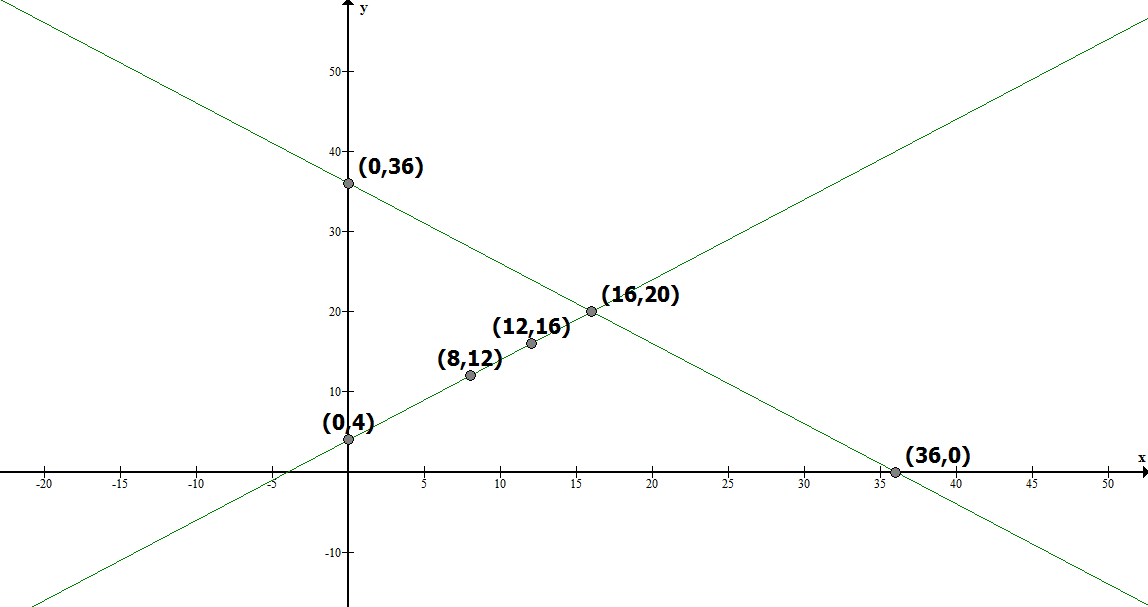
From the figure, it
can be observed that these lines are intersecting each other at only point
i.e., (16, 20). Therefore, the length and width of the given garden is 20 m and
16 m respectively.
6
Given the linear equation 2x + 3y - 8 = 0, write another linear equations in two variables such that the geometrical representation of the pair so formed is:
(i) intersecting lines
(ii) parallel lines
(iii) coincident lines
Answer
(i) Intersecting lines:
Equation of first line: 2x + 3y – 8 = 0
Let the equation of 2nd
line be ax + by + c = 0
Here,
a2 = a, b1 = b, c1 = c
The equation for second line is 2x + 4y - 6 = 0 which will follow the given condition as,

(ii) Parallel lines
Equation of first line: 2x + 3y – 8 = 0
Let the equation of 2nd line be ax + by + c = 0
Condition for the lines to be parallel,
![]()
Here,
a1 = 2, b1 = 3, c1 = -8
a2 = a, b1 = b, c1 = c
Hence, the equation for second line can be 4x + 6y - 8 = 0 as
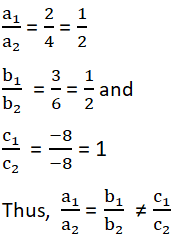
(iii) Coincident lines
Equation of first line: 2x + 3y – 8 = 0
Let the equation of 2nd line be ax + by + c = 0
Condition for the lines to be coincident,
![]()
Hence, the equation of second line can be 6x + 9y - 24 = 0 as,
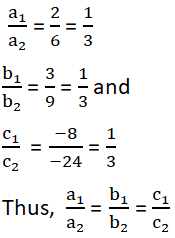
7
Answer
x - y + 1 = 0
⇒ x = y - 1
|
x |
0 |
1 |
2 |
|
y |
1 |
2 |
3 |
3x + 2y - 12 = 0
⇒ x = 12 -![]()
|
x |
4 |
2 |
0 |
|
y |
0 |
3 |
6 |
Graphical representation

From the figure, it
can be observed that these lines are intersecting each other at point (2, 3)
and x-axis at (- 1, 0) and (4, 0). Therefore, the vertices of the triangle
are (2, 3), (- 1, 0), and (4, 0).
1
Solve the following pair of linear equations by the substitution method.
(i) x + y = 14
x – y = 4
(ii) s – t = 3
![]()
(iii) 3x – y = 3
9x – 3y = 9
(iv) 0.2x + 0.3y = 1.3
0.4x + 0.5y = 2.3
(v)
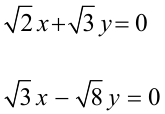
(vi)
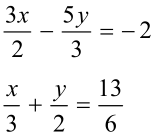
Answer
(i) x + y = 14 ... (1)
x – y = 4 ... (2)
From equation (i), we get
x = 14 - y ... (3)
Putting this value in equation (2), we get
(14 - y) - y = 4
14 - 2y = 4
10 = 2y
y = 5 ... (4)
Putting this in equation (3),
we get
x = 9
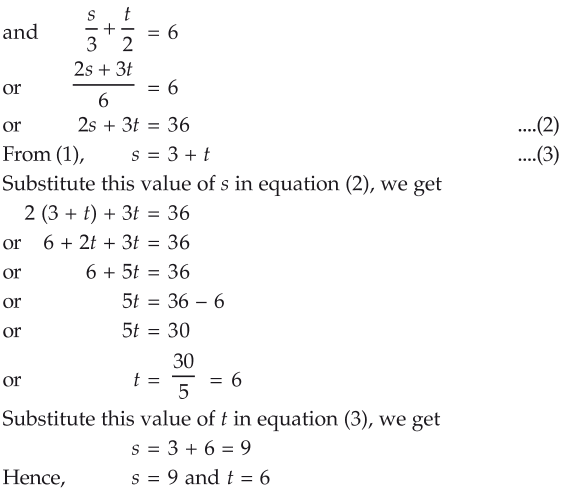
9x - 3y = 9 ... (2)
From equation (1), we get
y = 3x - 3 ... (3)
Putting this value in equation (2), we get
9x - 3(3x - 3) = 9
9x - 9x + 9 = 9
9 = 9
This is always true.
Hence, the given pair of equations has infinite possible solutions and the relation between these variables can be given by
y = 3x - 3
Therefore, one of its possible solutions is x = 1, y = 0.
0.4x + 0.5y = 2.3 ... (2)
0.2x + 0.3y = 1.3
Solving equation (1), we get
0.2x = 1.3 – 0.3y
Dividing by 0.2, we get
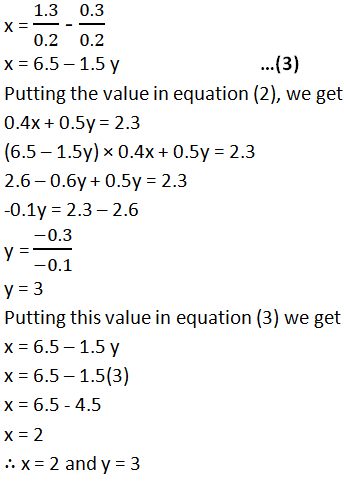
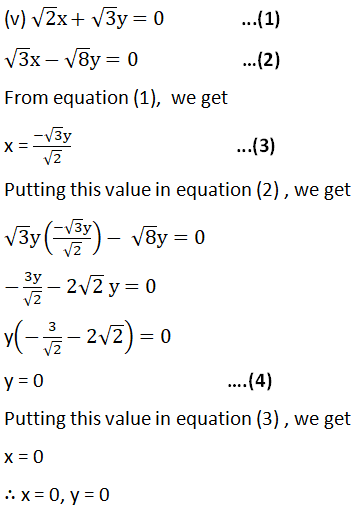
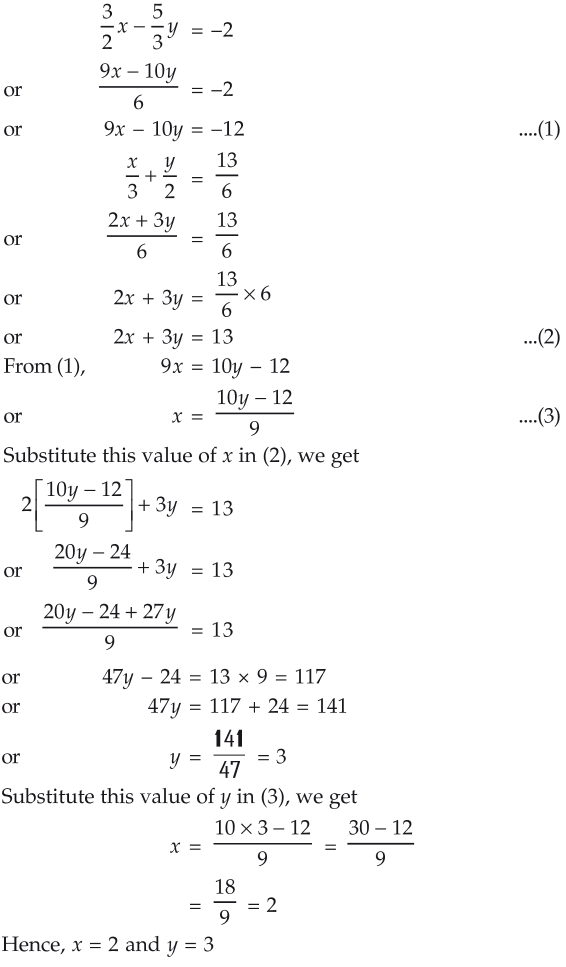
2
Answer
2x + 3y = 11 ... (1)
Subtracting 3y both side we get
2x = 11 – 3y … (2)
Putting this value in equation
second we get
2x – 4y = – 24 … (3)
11- 3y – 4y = - 24
7y = - 24 – 11
-7y = - 35
y = -35/-7
y = 5
Putting this value in equation (3)
we get
2x = 11 – 3 × 5
2x = 11- 15
2x = - 4
Dividing by 2 we get
x = - 2
Putting the value of x and y
y = mx + 3.
5 = -2m +3
2m = 3 – 5
m = -2/2
m = -1
3(i)
Answer
Let larger number = xSmaller number = y
The difference between two numbers is 26
x – y = 26
x = 26 + y --- (1)
Given that one number is three times the other
So, x = 3y --- (2)
Putting the value of x from (1) we get
26y = 3y
⇒ -2y = - 26
⇒ y = 13
So value of x = 3y
Putting value of y, we get
x = 3 × 13 = 39
Hence the numbers are 13 and 39.
3(ii)
The larger of two supplementary angles exceeds the smaller by 18 degrees. Find them.
Answer
Let first angle = x
And second number = y
As both angles are supplementary so that sum will 180°.
x + y = 180°
⇒
x = 180° - y ...(1)
Difference is 18° so,
x – y = 18
Putting the value of x we get
180° – y – y = 18°
- 2y = -162°
⇒
y = -162/-2
⇒
y = 81°
Putting the value in equation (1), we get
x = 180° – 81° = 99°
Hence, the angles are 99° and
81°.
3(iii)
Answer
Let cost of each bat = Rs x
Given that coach of a cricket team buys 7 bats and 6 balls for Rs 3800.
7x + 6y = 3800
⇒ 6y = 3800 – 7x
Dividing by 6, we get
3x + 5y = 1750
Putting the value of y
⇒ y = 300/6
⇒ y = 50
Hence cost of each bat = Rs 500 and cost of each balls = Rs 50.
3(iv)
Answer
Let the fixed charge for taxi =
Rs x
And variable cost per km =
Rs y
Total cost = fixed charge + variable charge
Given that for a distance of 10 km, the charge paid is Rs 105
x + 10y = 105 … (1)
⇒
x = 105 – 10y
Given that for a journey of 15 km, the charge paid is Rs 155
x + 15y = 155
Putting the value of x we get
105 – 10y + 15y = 155
⇒
5y = 155 – 105
⇒
5y = 50
Dividing by 5, we get
y = 50/5 = 10
Putting this value in equation (1) we get
x = 105 – (10 × 10)
⇒
x = 5
People have to pay for traveling a distance of 25 km
= x + 25y
= 5 + 25 × 10
= 5 + 250
= 255
3(v)
Answer
Let Numerator = x
Denominator = y
Fraction will = x/y
11x + 22 = 9y + 18
Subtracting 22 both side, we get
11x = 9y – 4
Dividing by 11, we get
If 3 is added to both the numerator and the denominator it becomes 5/6
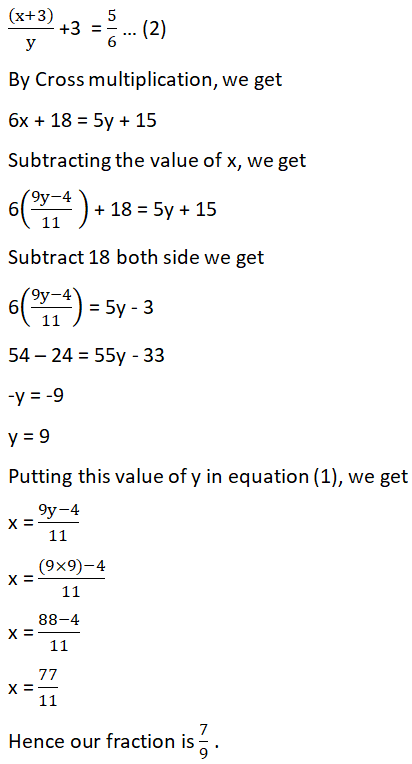
3(vi)
Answer
Let present age of Jacob = x year
And present Age of his son is = y year
Five years hence,
Age of Jacob will = x + 5 year
Age of his son will = y + 5year
Given that the age of Jacob will be three times that of his son
x + 5 = 3(y + 5)
Adding 5 both side, we get
x = 3y + 15 - 5
⇒ x = 3y + 10
… (1)
Five years ago,
Age of Jacob will = x - 5 year
Age of his son will = y - 5 year
Jacob’s age was seven times that of his son
x – 5 = 7(y -5)
Putting the value of x from equation (1) we get
3y + 10 – 5 = 7y – 35
⇒ 3y + 5 =
7y – 35
⇒ 3y – 7y =
-35 – 5
⇒ -4y = - 40
⇒ y = -40/-4
y = 10 years
Putting the value of y in equation
first we get
x = 3 × 10 + 10
x = 40 years
Hence, Present age of Jacob = 40 years and present age of his son = 10 years
1(i)
x + y =5 and 2x –3y = 4
Answer
x + y =5 and 2x –3y = 4By elimination method
x + y =5 ... (1)
2x –3y = 4 ... (2)
Multiplying equation (1) by (2), we get
2x + 2y = 10 ... (3)
2x –3y = 4 ... (2)
Subtracting equation (2) from equation (3), we get
5y = 6

By substitution method
Subtracting y both side, we get
x = 5 - y ... (4)
Putting the value of x in equation (2) we get
2(5 – y) – 3y = 4
⇒ -5y = - 6
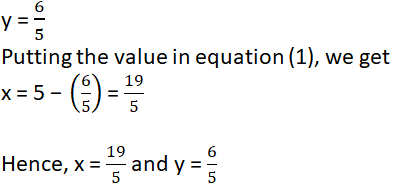
1(ii)
Answer
3x + 4y = 10 and 2x – 2y = 2By elimination method
3x + 4y = 10 ....(1)
2x – 2y = 2 ....(2)
Multiplying equation (2) by 2, we get
4x – 4y = 4 ....(3)
3x + 4y = 10 ....(1)
Adding equation (1) and (3), we get
7x + 0 = 14
Dividing both side by 7, we get
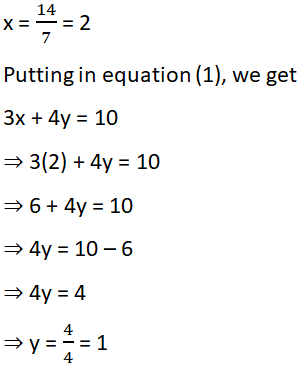
Hence, answer is x =
2, y = 1
3x + 4y = 10 ... (1)
Subtract 3x both side, we get
4y = 10 – 3x
Divide by 4 we get
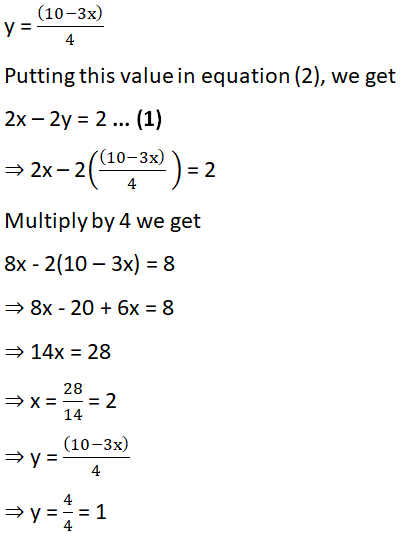
1(iii)
Answer
3x – 5y – 4 = 0 and 9x = 2y + 7By elimination method
3x – 5y – 4 = 0
⇒ 3x – 5y = 4 ...(1)
9x = 2y + 7
⇒ 9x – 2y = 7 ... (2)
Multiplying equation (1) by 3, we get
9x – 15y = 12 ... (3)
Subtracting equation (2) from equation (3), we get
(9x – 15y) – (9x – 2y) = 12 – 7
⇒ 9x – 15y – 9x + 2y = 5
⇒ -13y = 5
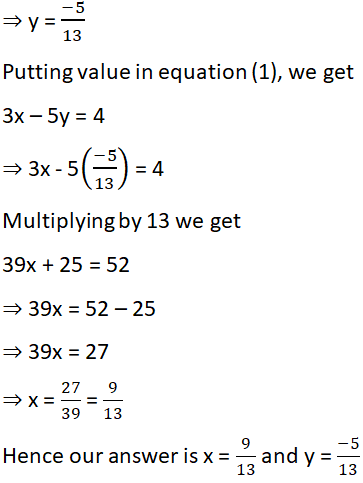
3x – 5y = 4 ... (1)
Adding 5y both side we get
3x – 5y + 5y = 4 + 5y
⇒ 3x = 4 + 5y
Dividing by 3 we get

9(4 + 5y) – 6y = 21
⇒ 36 + 45y – 6y = 21
⇒ 39y = 21 – 36
⇒ 39y = – 15
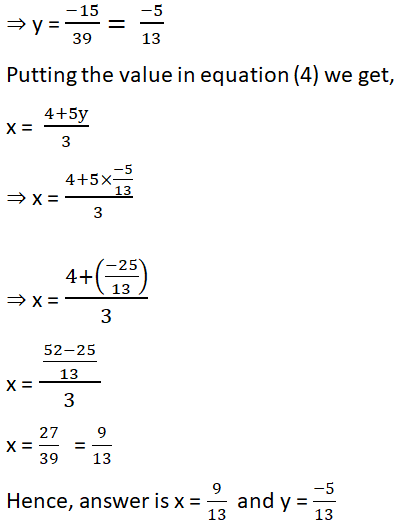
1(iv)
Answer
Given pair of linear equation is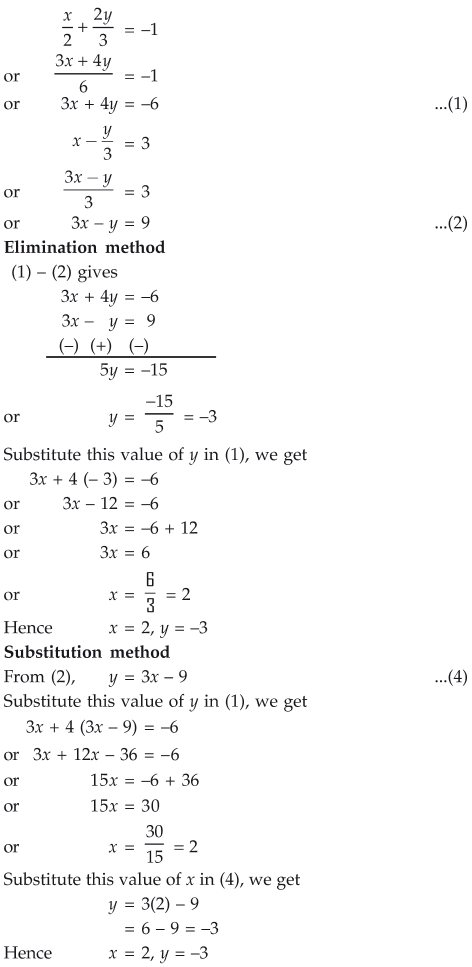
2(i)
Answer
Let the fraction be x/yAccording to the question,
⇒ x+1−y= −1
⇒ x−y = − 1−1
⇒ x − y = −2 ... (1)
⇒ 2x = y+1
⇒ 2x − y = 1 ... (2)
Subtracting equation (1) from equation (2), we get
(2x−y)− (x−y) = 1−(−2 )
⇒ 2x− y –x + y = 1+2
x = 3 ...(3)
Putting this value in equation (1), we get
x − y = −2
3− y = − 2
−y = −5
y = 5
Hence, the fraction is 3/5
2(ii)
Answer
Let present age of Nuri = xand present age of Sonu = y
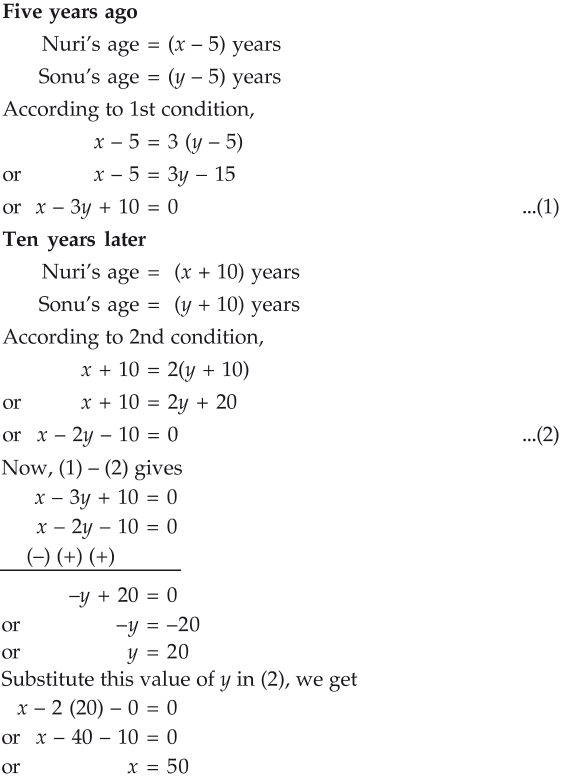
2(iii)
Answer
Let the unit digit and tens digits of the number be x and y respectively.Then, Required number = 10y + x
Number after reversing the digits = 10x + y
According to the question,
x + y = 9 ... (1)
9(10y + x) = 2(10x + y) [ given ]
⇒ 90y + 9x = 20x + 2y
⇒ 90y + 9x – 20x - 2y = 0
⇒ 88y - 11x = 0
⇒ 11(8y – x ) = 0
⇒ - x + 8y =0 ... (2)
Adding equation (1) and (2), we get
(x + y) + (-x + 8y) = 9 + 0
⇒ x+ y – x + 8y = 9
⇒ 9y = 9
⇒ y = 1 ... (3)
Putting the value in equation (1), we get
x + y = 9
x + 1 = 9
x = 9 – 1
x = 8
Hence, the number is 10y + x = 10×1 + 8 = 18.
2(iv)
Answer
Let Meena received x notes of Rs 50 and y notes of Rs 100.Multiplying equation (i) by 50, we get
50x + 50y = 1250 ... (3)
Subtracting equation (3) from equation (2), we get
(50x + 100y ) – (50x + 50y) = 2000 – 1250
⇒ 50x +100y – 50x – 50y = 750
⇒ 50y = 750
⇒ y = 15
Putting this value in equation (1), we get
x + y = 25
⇒ x + 15 = 25
⇒ x = 25 – 15
⇒ x = 10
Hence, Meena has 10 notes of Rs 50 and 15 notes of Rs 100.
2(v)
Answer
Let the fixed charge for first three days and each day charge thereafter be Rs x and Rs y respectively.According to the question,
x + 4y = 27 ... (1)
x + 2y = 21 ... (2)
Subtracting equation (2) from equation (1), we get
(x + 4y) – (x +2y) = 27 – 21
x + 4y – x – 2y = 6
2y = 6
y = 3 ... (3)
Putting the value in equation (1), we get
x + 4y = 27
⇒ x + 4×3 = 27
⇒ x + 12 =27
⇒ x = 27 – 12
⇒ x = 15
Hence, fixed charge = Rs 15 and Charge per day = Rs 3.
1
Which of the following pairs of linear equations has unique solution, no solution or infinitely many solutions? In case there is a unique solution, find it by using cross multiplication method.
(i) x – 3y – 3 = 0 ; 3x – 9y – 2 =0
(ii) 2x + y = 5 ; 3x +2y =8
(iii) 3x – 5y = 20 ; 6x – 10y =40
(iv) x – 3y – 7 = 0 ; 3x – 3y – 15= 0
Answer
(i) x – 3y – 3 = 03x – 9y – 2 =0
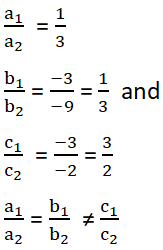
3x +2y = 8
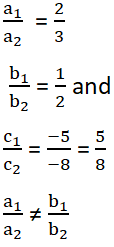
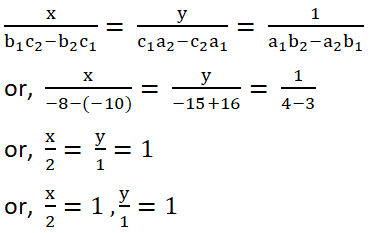
6x – 10y = 40
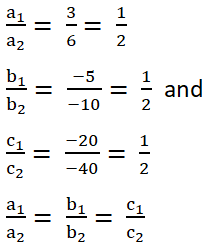
3x – 3y – 15= 0
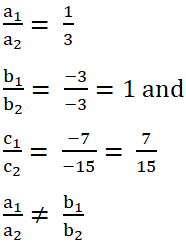
By cross-multiplication,

∴ x =4, y= −1
2
(i) For which values of a and b does the following pair of linear equations have an infinite number of solutions?
2x + 3y =7
(a – b)x + (a + b)y = 3a +b –2
(ii) For which value of k will the following pair of linear equations have no solution?
3x + y = 1
(2k –1)x + (k –1)y = 2k + 1
Answer
(i)
2x + 3y -7 = 0

− 4 = 7a – 7b – 6a – 2b
− 4 = a – 9b
a – 9b = − 4 …(1)
Also,
a – 5b = 0 ... (2)
Subtracting equation (1) from (2), we get
a −5b = 0
a – 9b = − 4 …(1)
4b = 4
b = 1
Putting this value in equation (2), we get
a −5 × 1 = 0
a = 5
Hence, a = 5 and b = 1 are the values for which the given equations give infinitely many solutions.
(ii)
3x + y -1 = 0
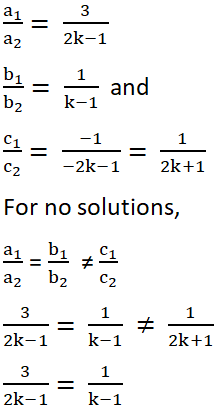
⇒ k = 2
Hence, for k = 2, the given equation has no solution.
3
8x +5y = 9
3x +2y = 4
Answer
8x +5y = 9 ... (1)3x +2y = 4 ... (2)
From equation (2), we get
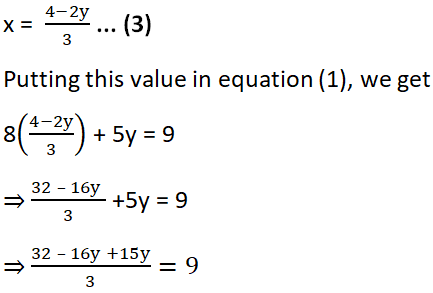
⇒ − y = 27 – 32
⇒ − y = −5
⇒ y = 5 ... (4)
Putting this value in equation (2), we get
3x +2y = 4 ... (2)
⇒ 3x + 2×5 = 4
⇒ 3x + 10 = 4
⇒ 3x = 4 – 10
⇒ x = -6/3
⇒ x = − 2
Hence, x = -2, y = 5
By cross multiplication again, we get
8x + 5y -9 = 0
3x + 2y - 4 = 0
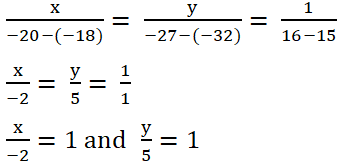
4(i)
A part of monthly hostel charges is fixed and the remaining depends on the number of days one has taken food in the mess. When a student A takes food for 20 days she has to pay Rs 1000 as hostel charges whereas a student B, who takes food for 26 days, pays Rs 1180 as hostel charges. Find the fixed charges and the cost of food per day.
Answer
Let x be the fixed charge of the food and y be
the charge for food per day.
According to the question,
x +
20y = 1000 ... (1)
x +
26y = 1180 ... (2)
Subtracting equation (1) from equation (2), we get
⇒ x + 26y - x - 20y = 1180 - 1100
⇒ 6y =
180
Putting this value in equation (1), we get
x + 20 × 30 = 1000
⇒ x = 1000 − 600
⇒ x = 400
Hence, fixed charge = Rs 400 and charge per day = Rs 30.
4(ii)
A fraction becomes 1/3 when 1 is subtracted from the numerator and it becomes 1/4 when 8 is added to its denominator. Find the fraction.
Answer
Let the fraction be x/y
According to the question,
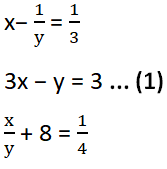
4x − y = 8 ... (2)
Subtracting equation (1) from equation (2), we get
4x − y = 8 ... (2)
3x − y = 3 ... (1)
⇒ 4x − y - 3x + y = 8 - 3
x = 5 ... (3)
Putting this value in equation (1), we get
3x − y = 3 ... (1)
⇒ 3×5 – y = 3
⇒ 15 – y = 3
⇒ y = 12
Hence, the fraction is ![]()
4(iii)
Answer
Let
the number of right answers and wrong answers
be x and y respectively.
According to the question,
3x - y = 40 ... (1)
4x - 2y = 50
⇒ 2x - y = 25 ... (2)
Subtracting equation (2) from equation (1),
we get
3x - y = 40 ... (1)
2x - y = 25 ... (2)
⇒ 3x - y - 2x + y = 40 - 25
x = 15 ... (3)
Putting this value in equation (2), we get
2x - y = 25 ... (2)
⇒ 2×15 – y = 25
⇒ 30 − y = 25
⇒ y = 5
Number of wrong answers = 5
Total number of questions = 20
4(iv)
Answer
Let the speed of 1st car and 2nd car be u km/h and v km/h.
Respective speed of both cars while they are travelling in
same direction = (u - v) km/h
Respective speed of both cars while they are travelling in
opposite directions i.e., travelling towards each other = (u + v)
km/h
According to the question,
5(u - v) = 100
u - v = 20 ... (1)
1(u + v) = 100 ... (2)
Adding both the equations, we get
⇒ u - v + u + v = 20 + 100
⇒ 2u = 120
⇒ u = 60 km/h ... (3)
Putting this value in equation (2), we obtain
Hence, speed of one car = 60 km/h and speed of other car = 40 km/h
4(v)
Answer
Let length and breadth of rectangle be x unit
and y unit respectively.
According to the question,
(x - 5) (y + 3) = xy – 9
⇒ 3x - 5y - 6 = 0 ... (1)
⇒ (x + 3) (y + 2) = xy + 67
2x - 3y - 61 = 0 ... (2)
By cross multiplication, we get

Hence, the length of the rectangle = 17 units and breadth of the rectangle = 9 units.
1(i)
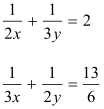
Answer
Given pair of equations are,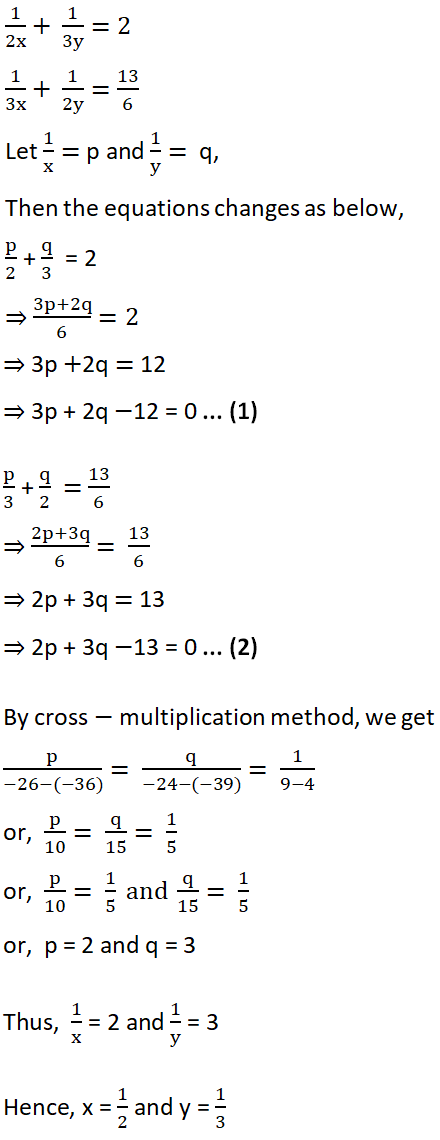
1(ii)

Answer
Given pair of equations are,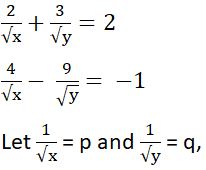
2p + 3q = 2 ... (1)
4p - 9q = -1 ... (2)
Multiplying equation (i) by 3, we get
6p + 9q = 6 ... (3)
Adding equation (2) and (3), we get
4p - 9q + 6p + 9q = -1 + 6
⇒ 10p = 5
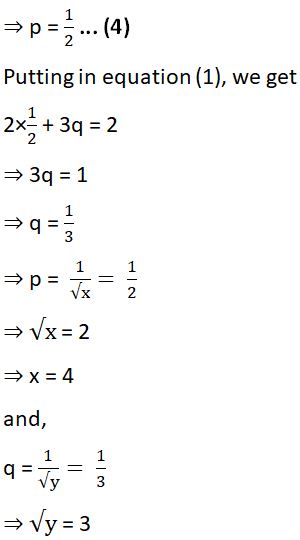
Hence, x = 4, y = 9
1(iii)

Answer
Given pair of equations are,
⇒ 4p + 3y - 14 = 0 …(1)
3p - 4y = 23
⇒ 3p - 4y -23 = 0 …(2)
By cross-multiplication, we get
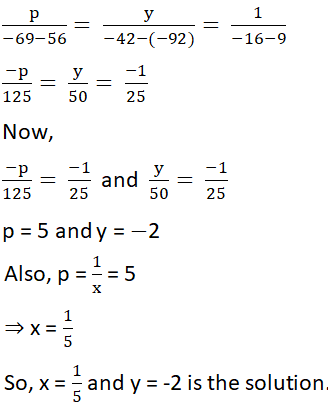
1(iv)
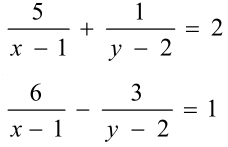
Answer
Given pair of equations are,
6p - 3q = 1 ... (2)
Now, by multiplying equation (1) by 3 we get
15p + 3q = 6 ... (3)
Now, adding equation (2) and (3)
6p - 3q = 1 ... (2)
15p + 3q = 6 ... (3)
21p = 7
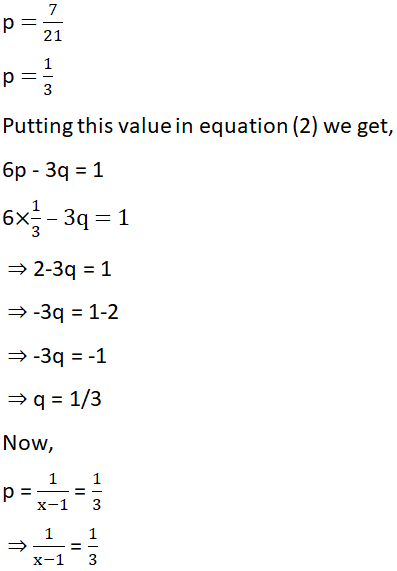
⇒ x = 4
Also,
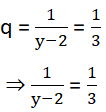
⇒ y = 5
Hence , x = 4 and y = 5
1(v)
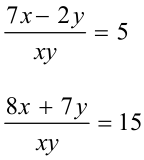
Answer
Given pair of equations are,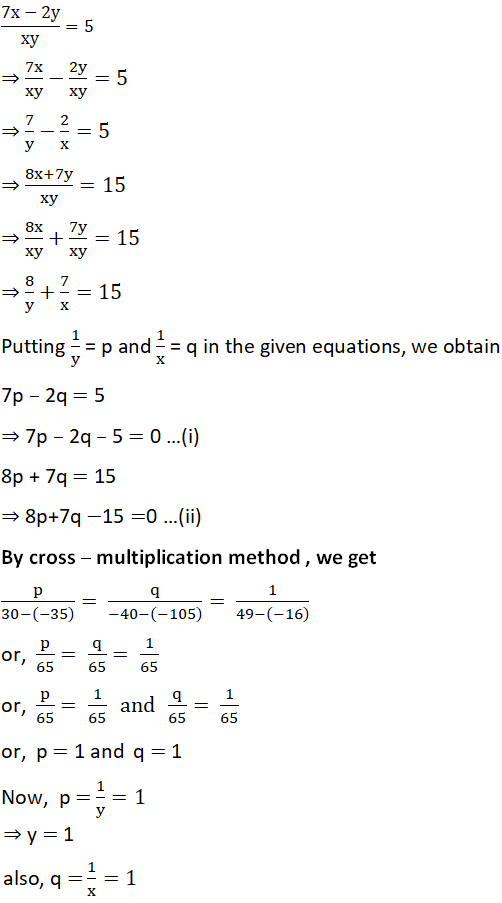
Hence , x = 1 and y = 1
1(vi)
2x + 4y = 5xy
Answer
Given pair of equations are,2x+4y = 5xy
Dividing by xy, we get
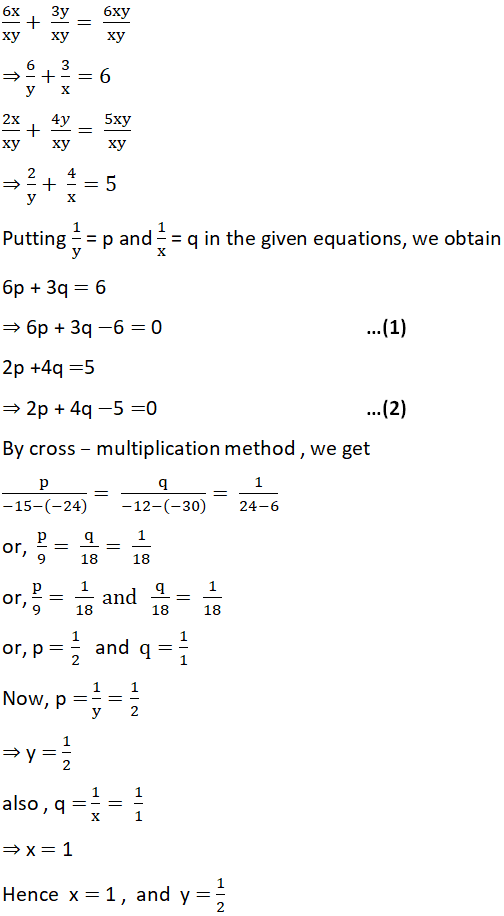
1(vii)
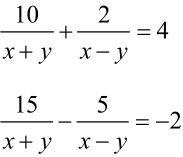
Answer
Given pair of equations,
⇒ 10p+2q− 4 = 0 …(1)
15p – 5q = −2
⇒ 15p – 5q +2 = 0 …(2)
By cross – multiplication method, we get
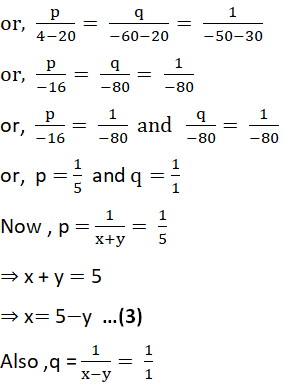
Putting value of x
(5−y)−y = 1
⇒ 5−y−y =1
⇒ −2y= −4
⇒ y = 2
From equation (3),
x = 5 – y
⇒ x = 5 – 2
⇒ x = 3
Hence , x = 3 and y = 2
1(viii)
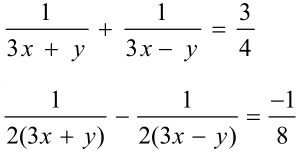
Answer
Given pair of equations are,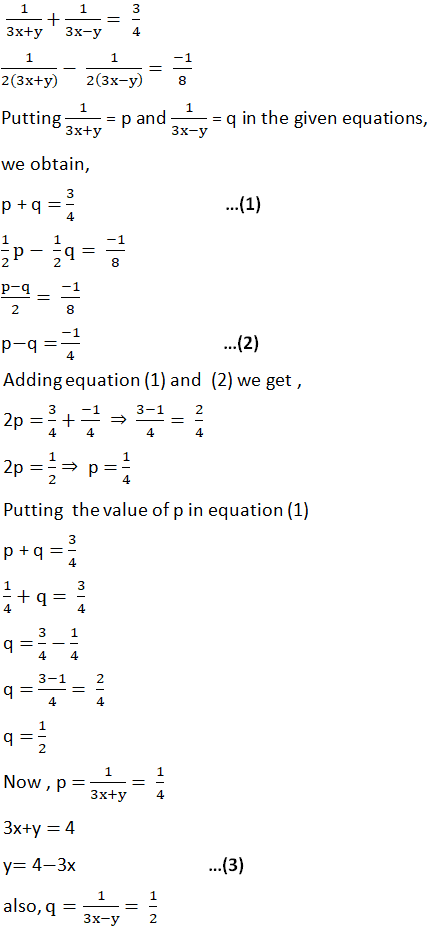
Putting value of y
3x – (4−3x) = 2
3x−4+3x =2
6x= 6
x =1
From equation (3),
y= 4− 3x
y= 4 – 3×1= 4−3
y= 1
Hence , x=1 and y = 1
2(i)
Answer
Let the speed of Ritu in still
water be x km/h
and the speed of stream be y km/h
Speed of Ritu while rowing,
Upstream = (x - y) km/h
Downstream = (x + y) km/h
According to question,
2(x + y) = 20
⇒ x + y = 10 ... (1)
2(x - y) = 4
⇒ x - y =
2 ... (2)
Adding equation (1) and (2), we get
x + y + x – y = 10 + 2
⇒
2x = 12
⇒
x = 6
Putting this equation in (1),
we get
y = 4
2(ii)
Answer
Let the
number of days taken by a woman be x
and a man
be y
Therefore, work done by a
woman in 1 day = 1/x
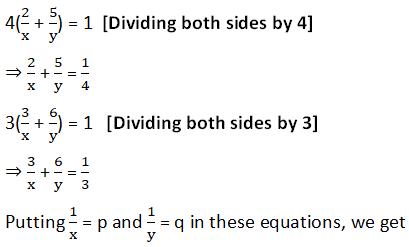
⇒ 8p + 20q =1
⇒ 8p +20q −1 = 0 …(1)
3p+6q= 1/3
⇒ 9p+18q= 1
⇒ 9p +18q−1 = 0 …(2)
By cross multiplication, we get
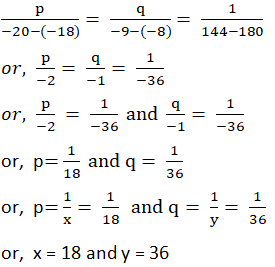
2(iii)
Answer
Let the speed of train be u km/h
and bus be v km/h respectively.
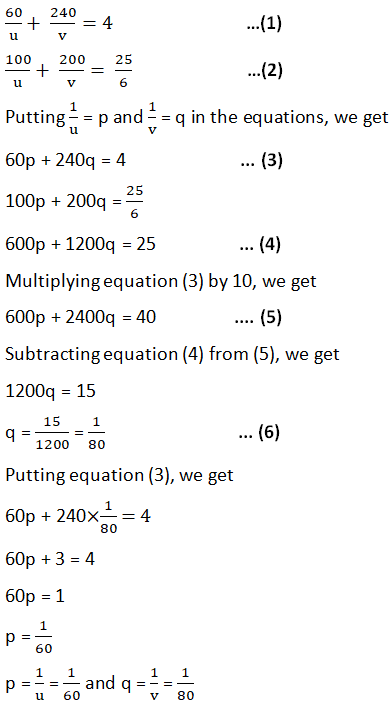
Hence, speed of train = 60 km/h and speed of bus = 80 km/h.
1
Answer
Let the ages of Ani and Biju be x year
and y year respectively.
According to the given condition,
x− y = ± 3 …(1)
Also, age of Ani’s father Dharam = 2x year
And age of Biju’s sister = y/2 year
According to the given question,
2x – y/2 = 30
⇒ 4x−y=60 …(2)
Case 1
When x−y=3 …(3)
On subtracting eq. (3)from eq. (2) we get ,
4x−y – x + y =60 – 3
⇒ 3x = 57
⇒ x = 19
On putting x=19 in eq.(3) we get
19−y=3
⇒ y=16
∴ x= 19 and y= 16
Case II
When x−y=−3 …(4)
On subtracting Eq. (4)from eq. (2) we get ,
4x−y – x +y = 60 + 3
⇒ 3x = 63
⇒ x =63/3
On putting x = 21 in eq.(4), we get
x−y = −3
⇒ 21 – y = −3
⇒ y =24
Hence, age of Ani is 19yrs and age of Biju is 16yrs and,
second age of Ani is 21yrs and age of Biju is 24yrs.
2
[ Hint x + 100 = 2 (y−100), y+10 =6(x−10)].
Answer
Let the amount of their respective
capital’s be ₹x and ₹y.
x+100 = 2(y – 100)
⇒ x−2y= −200−100
⇒ x−2y= −300 …(1)
and,
y + 10 = 6(x−10)
⇒ y − 6x = −60−10
⇒ y − 6x = −70
⇒ 6x−y = 70 …(2)
Multiplying eq. (2) by 2
2(6x−y = 70)
⇒ 12x−2y=140 …(3)
subtracting eq. (3) from eq. (1), we get
x−2y - 12x + 2y = −300 - 140
⇒ −11x = −300−140
⇒ − 11x = −440
⇒ x = 40
Putting the value of x in eq. (1), we get
x−2y= −300
⇒ 40 −2y = −300
⇒ −2y = −300−40
⇒ −2y = −340
⇒ y=170
Hence, x = ₹40 and y = ₹170.
3
Answer
Let the actual speed of the train be x kmh−1and actual time taken by train be y hour.
∵ Distance = speed × time =(xy) km
According to the given question,
xy = (x+10) (y−2)
⇒ xy = xy + 10y − 2x − 20
⇒ 2x − 10y + 20 = xy − xy
⇒ 2x−10y+20 = 0 …(1)
and,
xy = (x−10)(y+3)
⇒ xy = xy −10y + 3x − 30
⇒ xy − xy= 3x − 10y − 30
⇒ 3x−10y−30=0 …(2)
Subtracting eq. (1) from eq.(2), we get
3x − 10y − 30 - 2x + 10y - 20 =0
⇒ x−50=0
⇒ x = 50
Putting the value x in eq. (1), we get
2x − 10y + 20 = 0
⇒ 2×50 − 10y + 20 = 0
⇒ 100 −10y + 20 = 0
⇒ −10y = −120
⇒ y = 12
Hence, the distance covered by the train = xy = 50×12 = 600 km.
4
Answer
Let the number of students in the class = xand, the number of rows= y
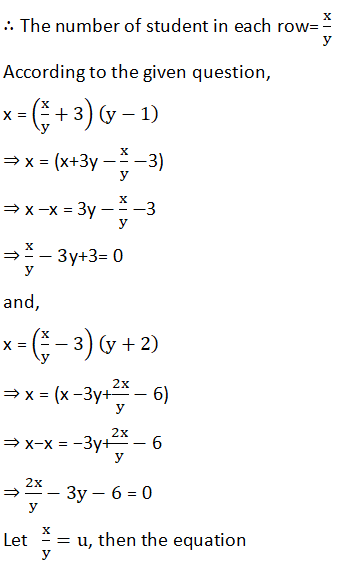
y+3= 0 …(1)
= 0 …(2)
Subtracting eq.(1) from eq.(2), we get
2u - 3y - 6 – u + 3y – 3 = 0
⇒ u - 9 = 0
⇒ u = 9
From eq.(1)
y+3= 0
⇒ 9 y +3=0
y = −12
⇒ y = 4

Hence, the number of student in the class = xy =36×4 = 144.
5
Answer
We have,∠C = 3∠B=2(∠A+∠B) …(1)
The sum of three angles of a triangle = 180°
∴ ∠A+∠B+∠C = 180°
⇒ ∠A+∠B+2(∠A+∠B)= 180°
⇒ ∠A+∠B+2∠A+2∠B= 180°
⇒ 3∠A+3∠B=180°
⇒ 3(∠A+∠B)=180°
⇒ ∠A+∠B = 180°/3
⇒ ∠A+∠B = 60° …(2)
Again,
∠A+∠B+∠C = 180°
⇒ ∠A+∠B +3∠B = 180°
⇒ ∠A+4∠B = 180° …(3)
Subtracting eq. (2) from eq.(3),
∠A + 4∠B - ∠A - ∠B = 180° - 60°
⇒ 3∠B = 120°
⇒ ∠B = 40°
putting the value of ∠B in eq. (2),
∠A+∠B = 60°
⇒ ∠A + 40°= 60°
⇒ ∠A = 20°
From eq.(1), we get
∠C= 3∠B
⇒ ∠C = 3×40°=120°
Hence, ∠A=20°, ∠B=40° and ∠C=120°.
6
Answer
The given equations are
5x−y = 5 …(1)
3x – y = 3 …(2)
Table for 5x−y = 5
|
X |
1 |
0 |
|
Y |
0 |
−5 |
|
Points |
A |
B |
Table for 3x−y=3
|
X |
1 |
0 |
|
Y |
0 |
−3 |
|
Points |
C |
D |
Now, we plot the points A (1, 0) and B (0 , −5)
on a graph paper and join these points to form a line AB. Also we plot the
pointsC (1,0 )andD ( 0, −3) on the same graph paper and join these points form
the line CD.
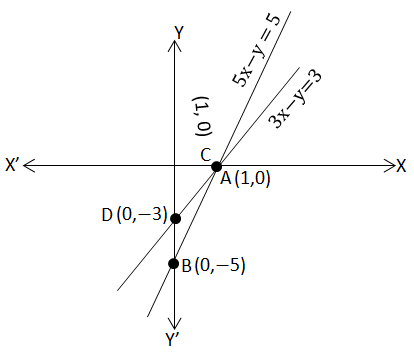
∴
Required triangle is of ∆
ABD and whose vertices are A ( 1, 0) B(0, −5) and D(0, −3).
7(i)
Answer
Given pair of linear equations ispx + qy = p−q …(1)
qx – py = p +q …(2)
Multiplying eq. (1) by p
p2x +pqy = p2 – pq …(3)
Multiplying eq. (2) by q
q2x – pqy = pq + q2 …(4)
adding eq. (3) and eq. (4),
p2x + q2x = p2+ q2
⇒ x (p2+ q2) = (p2+ q2)
⇒ x = 1
putting the value of x = 1 in eq(1), we get
px + qy = p−q
⇒ p×1 +qy = p− q
⇒ qy = p− q – p
⇒ qy = −q
⇒ y = −1
Hence, x = 1 and y = −1.
7(ii)
bx+ ay = 1+c
Answer
Given pair of linear equations isax+ by = c …(1)
bx+ ay = 1+c …(2)
Multiplying eq. (1) by a
a2x +aby = ac …(3)
Multiplying eq. (2) by b
b2x + aby = b+bc …(4)
Subtracting eq. (3) and eq. (4),
a2x − b2x = ac – b –bc
⇒ x (a2 − b2) = ac – b –bc
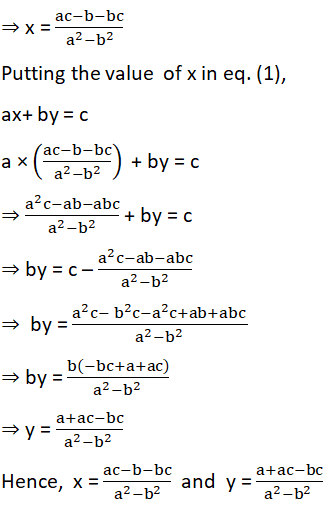
7(iii)

Answer
Given pair of linear equations is
⇒ bx –ay = 0 …(1)
ax +by = a2+ b2 …(2)
Multiplying eq. (1) by b
b2x –aby = 0 …(3)
Multiplying eq. (2) by a
a2x +aby = a(a2+ b2) …(4)
Adding eq. (3) and eq. (4),
b2x + a2x = a(a2+ b2)
Putting the value of x in eq. (1), we get
bx –ay = 0
⇒ b× a –ay = 0
⇒ –ay = − b× a
⇒ y = b
Hence, x = a and y = b.
7(iv)
(a+b)(x+y) = a2+b2
Answer
Given pair of linear equations is(a− b)x +(a+ b)y = a2 – 2ab – b2 …(1)
(a+ b)(x+ y) = a2+b2
⇒ (a+ b)x+ (a+ b)y = a2+b2 ….(2)
Subtracting eq. (2) from eq. (1) , we get
(a− b)x − (a+ b)x = (a2 – 2ab – b2) – (a2+b2 )
⇒ ax –bx –ax – bx = a2 – 2ab – b2 − a2 − b2
⇒ − 2bx = – 2ab − 2b2
⇒ − 2bx = − 2b(a+ b)
⇒ x = a+ b
Putting the value of x in eq.(1)
(a− b)x +(a+ b)y = a2 – 2ab – b2
⇒ (a− b)(a+b) + (a+ b)y = a2 – 2ab – b2
⇒ a2 – ab + ab – b2 + (a+ b)y = a2 – 2ab – b2
⇒ (a+ b)y = a2 – 2ab – b2 − a2 +ab – ab + b2
⇒ (a+ b)y = – 2ab

7(v)
− 378x+152y = −604
Answer
Given pair of linear equations is
152x− 378y = −74 ...(1)
− 378x+152y = −604 ...(2)
Adding eq.(1) and eq.(2)
152x− 378y − 378x + 152y = −74 - 604
⇒ −226x −226y = −678
⇒ −226(x+ y) = −678
⇒ x+ y = -678/-226
⇒ x+ y = 3 ….(3)
Subtracting eq.(2) from eq. (1)
152x− 378y + 378x - 152y = −74 + 604
⇒ 530x − 530y = 530
⇒ 530(x−y) = 530
⇒ (x−y) =
⇒ x−y = 1 ….(4)
Adding eq(3) and eq (4) , we get
x+ y + x – y = 3 + 1
⇒ 2x = 4
⇒ x = 2
Putting x = 2 in eq. (3),
x+ y = 3
⇒ 2+y = 3
⇒ y = 3−2
⇒ y = 1
Hence x=2 and y =1.
8

Answer
Since, in cyclic quadrilateral, the sum of two opposite angles is 1800.
∴ ∠B+ ∠D = 180°
⇒ 3y−5 −7x +5= 180°
⇒ 3y −7x = 180° …. (1)
and ∠A+ ∠C = 180°
⇒ 4y + 20 − 4x = 180°
⇒ 4y – 4x = 180° − 20°
⇒ 4y − 4x = 160°
⇒ 4(y−x) = 160°
⇒ y−x = 160°/4
⇒ y−x = 400 ….(2)
Multiplying eq. (2) by 7,
7(y−x) = 2×40°
⇒ 7y −7x = 280° ….(3)
Subtracting eq. (2) from eq. (1), we get
3y −7x – 7x + 7x = 180° - 280 °
⇒ −4y = −100°
⇒ y = -100°/-4
⇒ y =
Putting y = 25° in eq. (2),
y−x = 40°
⇒ −x = 400
⇒ − x = 40° − 25°
⇒ −x = 15°
⇒ x = − 15°
Hence, x = −15° and y = 25°